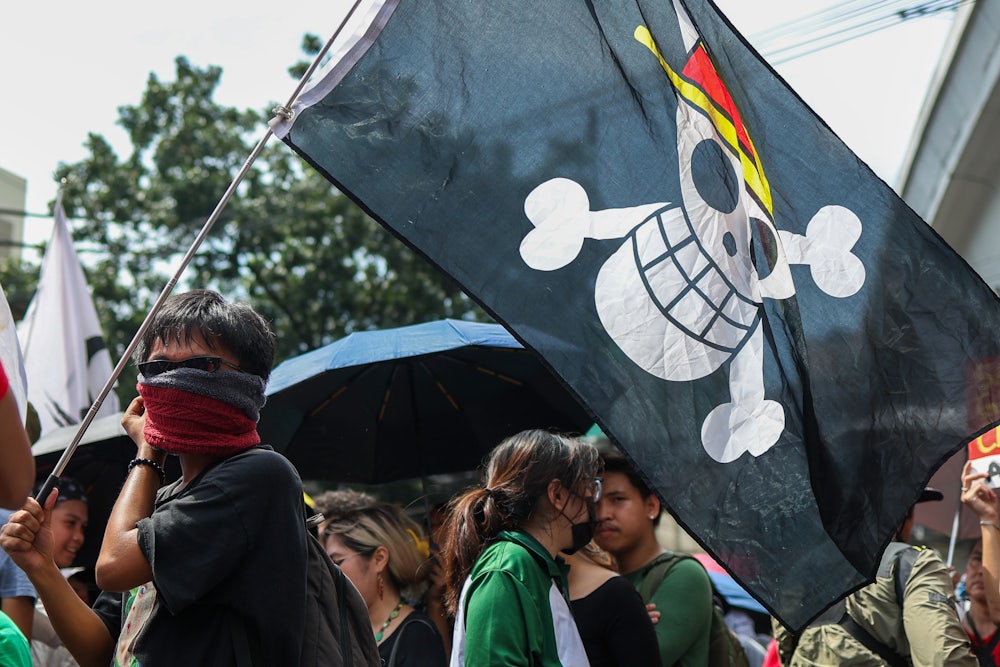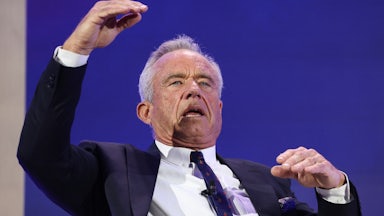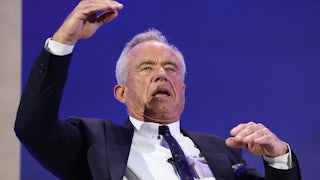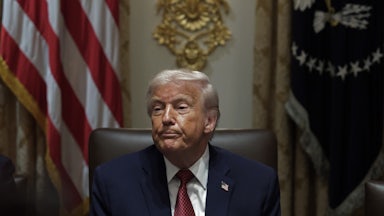The countrywide No Kings demonstrations protesting the Trump administration earlier this month were rife with pop culture references, with signs and costumes referencing media properties as varied as Spongebob Squarepants and Star Wars. Less prolific, but still present, were flags featuring a cartoon skull and crossbones wearing a straw hat. That flag, drawn from the internationally popular manga and anime series One Piece, has become a symbol for youth-led protests worldwide—and a trend that’s increasingly present on these shores.
The One Piece Jolly Roger flag has been a prominent element of recent demonstrations spearheaded by Gen Zers in countries such as Nepal, Indonesia, Madagascar, the Philippines, East Timor, Bolivia, Peru, and Morocco. In Nepal and Madagascar, these protests have been a key factor in the ouster of disfavored political leaders. The flag has especially served as a rallying cry for young protesters, who are drawn by the way it embodies the manga’s themes of resistance against an oppressive, autocratic regime and pursuing freedom.
The series centers around Monkey D. Luffy, a young pirate captain, who along with his ragtag “Straw Hat” crew seeks a treasure known as the “one piece,” a quest that positions them directly against the autocratic status quo. To Luffy, the act of piracy is one of liberation, not being bound by the strictures of the dictatorial World Government.
The prevalence of the One Piece flag demonstrates how pop culture can inspire the “civic imagination,” said Henry Jenkins, a professor at USC Annenberg who has written several books on the connection between media, fandom, and politics. For young people in Asia in particular, where anime is deeply embedded in the popular culture, One Piece can offer both a universal cultural touchstone and an example of what resistance can look like in a real-world context.
“These protests seek to find a role, an empowering role, that young people can embrace and perform through their protest, and a pirate is a very good one in that way,” said Jenkins. “Before you can change the world, you have to know what a better world looks like. You have to imagine that. You have to imagine yourself a civic agent capable of change.”
While American cultural touchstones may be more heterogeneous than in other countries, references to anime and manga in national protests could soon become more mainstream. Once considered a niche interest, anime is becoming increasingly popular in the United States, particularly among young Americans. A survey of nearly 5,000 adults released by Polygon last year found that 42 percent of respondents who identified as Gen Z said they watched anime weekly.
The growing popularity of this form is exemplified by anime’s recent dominance at the American box office. In September, Demon Slayer: Kimetsu No Yaiba—The Movie: Infinity Castle smashed expectations by earning $70 million in its first weekend in U.S. theaters. It is the highest-grossing anime film ever released in the U.S. But the success of Infinity Castle—the first in a planned trilogy—doesn’t seem to be a fluke. This past weekend, Chainsaw Man—The Movie: Reze Arc was the highest-grossing film in the domestic box office, easily beating out a Bruce Springsteen biopic and a new movie based on a novel by popular author Colleen Hoover.
One Piece may have particular cachet because it has been embedded in the cultural consciousness for as long—or longer—than many Gen Zers have been alive. The One Piece manga has been in circulation since 1997. The anime based on the manga, which began airing in 1999, has more than 1,100 episodes. A 2023 live-action adaptation on Netflix was popular with audiences and critics, and reaffirmed the franchise’s popularity; it is the bestselling manga of all time.
“If you have to pick one anime that you know people are most likely to watch, you know, it might well be One Piece, because it’s so popular and so long-running,” said Andrea Horbinski, an expert on manga and anime with a Ph.D. in modern Japanese history. “There is a vocabulary of shared, key moments among anime fans, and certainly, I think One Piece is definitely one of the ones in that vocabulary.”
Recent protests against the Trump administration have also included an aspect of playfulness, with inflatable animal costumes becoming an increasingly popular outfit for demonstrators. The symbolism of One Piece, with its nautical whimsy and charming characters, could provide a similar element of fun for young protesters.
“To get people to come out,” said Horbinski, “you want people to think, ‘A protest is a fun and useful use of my time,’ especially if they haven’t gone out to a protest before. To that extent, having the One Piece flag there, and maybe people dress up as pirates … that can also, you know, help contribute to people’s decisions to go out to the next one.”
Anime is incredibly popular across Asia, and its universality—combined with the longevity and relevance of One Piece—may make it a more potent symbol for young people in countries that are significantly smaller and more culturally homogenous than the United States. The timbre of protests in autocratic countries is also different from their American counterparts’. Jenkins said that protesters in countries such as Nepal and Madagascar uniting around One Piece are pushing back against a preexisting repressive government, whereas American anti-Trump demonstrators are resisting what they see as a slide into autocracy that hasn’t yet occurred.
Horbinski added that American protesters may bring the One Piece Jolly Roger flag to demonstrations because they are inspired by their counterparts in other countries, in addition to the specific meaning that the symbol may have for fans of the series.
“If you are bringing the flag, and you see yourself in solidarity with protesters in Nepal and Indonesia, then that’s a statement about democracy and about what you think is wrong with the situation you are protesting. And if you bring it because it’s One Piece, then that is also a statement about what you see as the problem,” said Horbinski.
When considering pop culture in American protests, Star Wars has been a dominant reference point. The release this year of season 2 of the acclaimed show Andor, which centers on the rebellion against an evil Empire, has brought the imagery of Star Wars to the fore once again in the American cultural consciousness. (Signs reading, “I have friends everywhere”—a cri de coeur of that series’ resistance movement—have become increasingly ubiquitous at anti-Trump rallies.) But Star Wars is far from the only popular media referenced by protesters. The varied cultural references in American contemporary protests are indicative of what demonstrators wish to accomplish, continued Jenkins: not simply a resistance against a particular regime, but an expression of unity through variety.
“Right now, we’re expressing the idea that democracy depends on many voices and is inclusive of people from many points of view, and maybe having so many diverse pop culture references is the best way to signify that,” he said.










